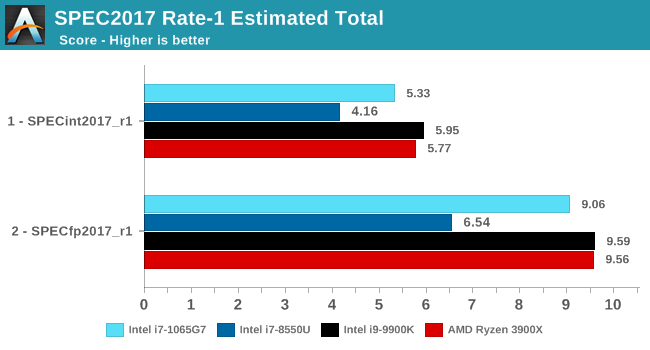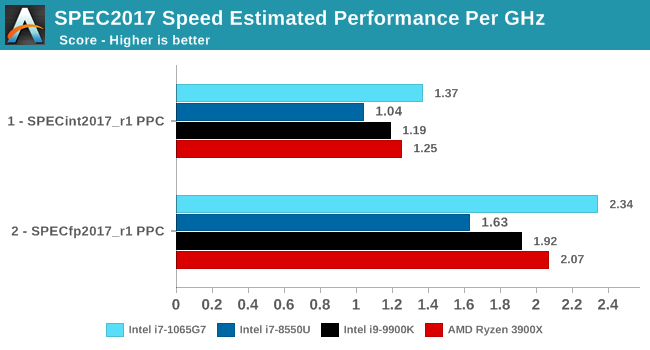The Ice Lake Benchmark Preview: Inside Intel's 10nm
by Dr. Ian Cutress on August 1, 2019 9:00 AM EST- Posted in
- CPUs
- Intel
- GPUs
- 10nm
- Core
- Ice Lake
- Cannon Lake
- Sunny Cove
- 10th Gen Core
Section by Andrei Frumusanu
SPEC2017 and SPEC2006 Results (15W)
SPEC2017 and SPEC2006 is a series of standardized tests used to probe the overall performance between different systems, different architectures, different microarchitectures, and setups. The code has to be compiled, and then the results can be submitted to an online database for comparsion. It covers a range of integer and floating point workloads, and can be very optimized for each CPU, so it is important to check how the benchmarks are being compiled and run.
We run the tests in a harness built through Windows Subsystem for Linux, developed by our own Andrei Frumusanu. WSL has some odd quirks, with one test not running due to a WSL fixed stack size, but for like-for-like testing is good enough. SPEC2006 is deprecated in favor of 2017, but remains an interesting comparison point in our data. Because our scores aren’t official submissions, as per SPEC guidelines we have to declare them as internal estimates from our part.
For compilers, we use LLVM both for C/C++ and Fortan tests, and for Fortran we’re using the Flang compiler. The rationale of using LLVM over GCC is better cross-platform comparisons to platforms that have only have LLVM support and future articles where we’ll investigate this aspect more. We’re not considering closed-sourced compilers such as MSVC or ICC.
clang version 8.0.0-svn350067-1~exp1+0~20181226174230.701~1.gbp6019f2 (trunk)
clang version 7.0.1 (ssh://git@github.com/flang-compiler/flang-driver.git
24bd54da5c41af04838bbe7b68f830840d47fc03)-Ofast -fomit-frame-pointer
-march=x86-64
-mtune=core-avx2
-mfma -mavx -mavx2
Our compiler flags are straightforward, with basic –Ofast and relevant ISA switches to allow for AVX2 instructions. Despite ICL supporting AVX-512, we have not currently implemented it, as it requires a much greater level of finesse with instruction packing. The best AVX-512 software uses hand-crafted intrinsics to provide the instructions, as per our 3PDM AVX-512 test later in the review.
For these comparisons, we will be picking out CPUs from across our dataset to provide context. Some of these might be higher power processors, it should be noted.
SPECint2006

Amongst SPECint2006, the one benchmark that really stands out beyond all the rest is the 473.astar. Here the new Sunny Cove core is showcasing some exceptional IPC gains, nearly doubling the performance over the 8550U even though it’s clocked 100MHz lower. The benchmark is extremely branch misprediction sensitive, and the only conclusion we can get to rationalise this increase is that the new branch predictors on Sunny Cove are doing an outstanding job and represent a massive improvement over Skylake.
456.hmmer and 464.h264ref are very execution bound and have the highest actual instructions per clock metrics in this suite. Here it’s very possible that Sunny Cove’s vastly increased out-of-order window is able to extract a lot more ILP out of the program and thus gain significant increases in IPC. It’s impressive that the 3.9GHz core here manages to match and outpace the 9900K’s 5GHz Skylake core.
Other benchmarks here which are limited by other µarch characteristics have various increases depending on the workload. Sunny Cove doubled L2 cache should certainly help with workloads like 403.gcc and others. However because we’re also memory latency limited on this platform the increases aren’t quite as large as we’d expect from a desktop variant of ICL.

In SPECfp2006, Sunny Cove’s wider out-of-order window can again be seen in tests such as 453.povray as the core is posting some impressive gains over the 8550U at similar clocks. 470.lbm is also instruction window as well as data store heavy – the core’s doubled store bandwidth here certainly helps it.

Overall in SPEC2006, the new i7-1065G7 beats a similarly clocked i7-8550U by a hefty 29% in the int suite and 34% in the fp suite. Of course this performance gap will be a lot smaller against 9th gen mobile H-parts at higher clocks, but these are also higher TDP products.
The 1065G7 comes quite close to the fastest desktop parts, however it’s likely it’ll need a desktop memory subsystem in order to catch up in total peak absolute performance.

Performance per clock increases on the new Sunny Cove architecture are outstandingly good. IPC increases against the mobile Skylake are 33 and 38% in the integer and fp suites, though we also have to keep in d mind these figures go beyond just the Sunny Cove architecture and also include improvements through the new LPDDR4X memory controllers.
Against a 9900K, although apples and oranges, we’re seeing 13% and 14% IPC increases. These figures likely would be higher on an eventual desktop Sunny Cove part.
SPEC2017



The SPEC2017 results look similar to the 2006 ones. Against the 8550U, we’re seeing grand performance uplifts, just shy of the best desktop processors.

Here the IPC increase also look extremely solid. In the SPECin2017 suite the Ice Lake part achieves a 14% increase over the 9900K, however we also see a very impressive 21% increase in the fp suite.
Overall in the 2017 suite, we’re seeing a 19% increase in IPC over the 9900K, which roughly matches Intel’s advertised metric of 18% IPC increase.










261 Comments
View All Comments
Ratman6161 - Wednesday, August 7, 2019 - link
"Did we really learn something new from this piece? Not really would be my answer."Actually I learned something. To me this showed that once Ice Lake systems hit the market, it will be time for me to start looking for a deal on A Whiskey Lake system. We see potential performance increases in some things but not others and the things more interesting to me personally fall into the tests where there isn't much difference.
Besides, everyone understands this is a pre-release system and much more data will be needed to really make a decision...at least I thought everyone understands. My personal experience with laptops in general has been that how good the cooling performance is is probably the most important factor in real world performance as most of them will thermal throttle long before you get any kind of sustained performance out of them anyway.
casperes1996 - Thursday, August 1, 2019 - link
Don't let comments like this get to you, Ian.It was an excellent article, considering the limited time you had with the platform. There will always be people calling fanboyism or the like no matter which company is in focus. You balanced it all as well as you could with the time you had the device for, and it was a great read.
If anything I'd actually say it sometimes came off as being a bit anti-Intel; Not in terms of their products, but the whole thing with them trying to involve themselves more in how you test their stuff, perhaps to their advantage. Sometimes sounded a bit "Just let me do my job and I'll let you do yours". But I thought that was kinda good ;)
eva02langley - Friday, August 2, 2019 - link
Well, the thing is more about the free advertisement. You are not the only one who went there. Toms did and their testing are downright different from yours. I believe your numbers way more than theirs, however there is a cost of being part of scheme like this.CityBlue - Saturday, August 3, 2019 - link
> We do our own validation of the platform to remove as much Intel involvement as possible.You say that, but it's difficult to believe Anandtech can be trusted when you botched the Ryzen 3 benchmark reviews so so badly and have subsequently been in denial ever since (looking at you, Ryan on reddit).
You personally have suggested that security isn't important so any performance impact resulting from security mitigations doesn't sound like something you would personally care about, thus playing right into the hands of a firm like Intel.
So, can you trusted? That would be a big fat "no" from me, I'm afraid.
Jorgp2 - Thursday, August 1, 2019 - link
Lol, this is exactly what qualcomm does.Its just a preview, they will do better testing at release.
brakdoo - Thursday, August 1, 2019 - link
Yeah the Qualcomm pieces were problematic too because they could have just released a few benchmarks (and they did) to give us a rough understanding of the performance.The real power consumption and performance (especially therm. throttled) came later in real world tests.
It was not until Andrei compared the 855 to the Kirin 980 when we saw the Kirin to be slightly faster and more efficient in pure CPU tests.
At least Qualcomm made real statements about release dates and those chips being really high volume. We still don't know whether or not Ice Lake will be in just a few laptops.
Andrei Frumusanu - Thursday, August 1, 2019 - link
The 855 preview contained almost our whole test suite, with just the thermal GPU tests missing due to lack of time.> It was not until Andrei compared the 855 to the Kirin 980 when we saw the Kirin to be slightly faster and more efficient in pure CPU tests.
This was included in the preview, and not later:
https://www.anandtech.com/show/13786/snapdragon-85...
The S10 review essentially had no changes on those numbers.
Valantar - Saturday, August 3, 2019 - link
brakdoo: your stance here is nonsense. You're arguing that it's _more_ problematic to accept special access to do your own independent testing than it is to simply accept a company's marketing statements in good faith? That makes _zero_ sense, and is certainly not how journalism is supposed to work. Articles like this are very valuable as they give interested readers information that can be trusted to a certain degree (even if the test platform isn't what they're going to be buying in the future), unlike marketing statements which always have some spin.Ian: Excellent article, and good job getting all that work done in just eight hours. Keep up the good work.
FunBunny2 - Thursday, August 1, 2019 - link
"Now 5G is just sub-6 and the only important part is massive MIMO"cute. I've been, ever since 5G was a twinkle in the eye of whoever, that mmWave 5G was, and always will be, vaporware. getting it to work in the real world, when engineers and scientists have known for decades how microwave (and near) propagates, is a non-starter. the telecom BS has reached ever new highs.
Eletriarnation - Thursday, August 1, 2019 - link
This seems like a good thing to me - we're getting useful information earlier, even if it is limited in scope. It's not like AMD offered the same and you turned them down. Keep up the good work!